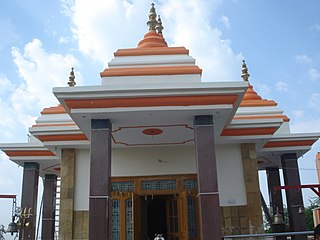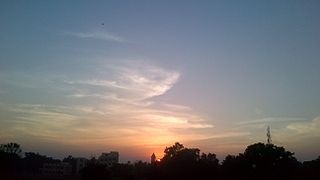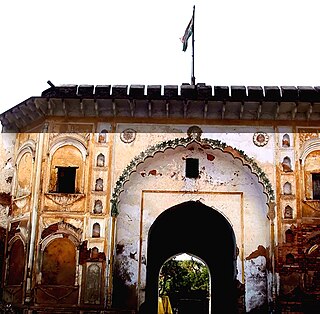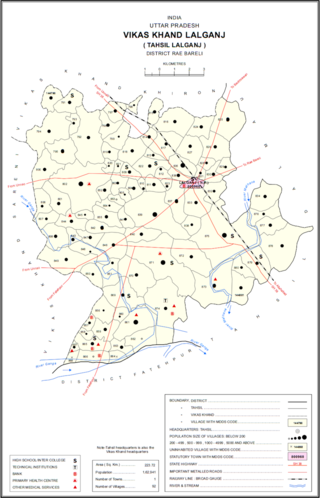Mainpuri is a city in Mainpuri district in the Indian state of Uttar Pradesh. It is the administrative headquarters of Mainpuri district and is situated to the north-east of Agra and is 270 km from New Delhi. Mainpuri is located in the Braj region, which holds special religious significance to Hindus as the homeland of Krishna.

Firozabad is a city near Agra in Firozabad district in the state of Uttar Pradesh in India. It is the centre of India's glassmaking industry and is known for the quality of the bangles and also glasswares produced there.

Etah district is one of the districts of Uttar Pradesh, India, since 1854. Etah City is the district headquarters. Etah district is a part of Aligarh Division.

Mainpuri district is one of the districts in the Agra division of Uttar Pradesh, India. Mainpuri town is the district headquarters. It consists of six tehsils, namely Mainpuri, Bhongaon, Karhal, Kishni, Kurawali and Ghiror.

Kannauj district is an administrative district of Uttar Pradesh state in northern India, along the river Ganges. The historic town of Kannauj, northwest of Kanpur, is the administrative center. The district was carved out of Farrukhabad district on 18 September 1997. The native dialect of this district is Kannauji.
Ghiror, also spelled Ghiraur, is a town and a nagar panchayat in Mainpuri district in the state of Uttar Pradesh, India. It is also the headquarters of a community development block comprising 74 villages. As of 2011, Ghiror has a population of 15,911, in 2,687 households.
Karhal is a town and Nagar Panchayat in Mainpuri district in the Indian state of Uttar Pradesh. It is also a Tehsil, that is subdivided into two blocks, Karhal and Barnahal. It is one of the Vidhan Sabha constituency of Uttar Pradesh.
Kishni is a town in Bhongaon tehsil of Mainpuri district in the Indian state of Uttar Pradesh. It is also the seat of a community development block. As of 2011, the town of Kishni has a population of 11,098, in 5,832 households.

Purwa is a town and nagar panchayat in Unnao district, Uttar Pradesh, India. It is located 32 km southeast of Unnao, the district headquarters. Roads connect it with several major cities including Unnao, Lucknow, Kanpur, and Rae Bareli. As of 2011, its population is 24,467 people, in 4,128 households.

Sadabad is a town and a nagar panchayat in Hathras district in the Indian state of Uttar Pradesh.

Rau Karna is a village in Sikandarpur Sarausi block of Unnao district, Uttar Pradesh, India. It is located 11 km north of the city of Unnao, on the road to Hardoi. On the east side of the village is the Tinai, a small stream that dries up in hot weather. The village holds a market twice per week. Rau Karna is part of the nyaya panchayat circle of Banda Khera.

Makhi is a large village in Miyanganj block of Unnao district, Uttar Pradesh, India. It hosts a Ramlila fair for one day during the month of Kuar, and it also holds a market twice per week, on Mondays and Saturdays. The main items sold at the market are grain and vegetables. Makhi also has a train station on the Kanpur-Balamau line, between the stations at Safipur and Patiyara. As of 2011, its population is 13,786, in 2,503 households.

Inhauna is a village and corresponding in Singhpur block of Rae Bareli district, Uttar Pradesh, India. As of 2011, its population is 13,049, in 2,021 households. Located at the junction of the Raebareli-Rudauli and Lucknow-Jaunpur roads, Inhauna is an old town that once served as the seat of a pargana as well as (briefly) a tehsil, and it has the ruins of an old fort built under the Nawabs of Awadh. The old marketplace, known as Ratanganj, was built in 1863 by the tahsildar Ratan Narain. Markets are held twice per week, on Mondays and Thursdays, and most of the trade is in livestock.

Bahai is a village in Lalganj block of Rae Bareli district, Uttar Pradesh, India. It is located 8 km from Lalganj, the block and tehsil headquarters, to the east of the road to Dalmau. It is on high ground and is drained by two large streams that merge together further south before joining the Ganges.

Pilkha is a village in Dalmau block of Rae Bareli district, Uttar Pradesh, India. It is located 9 km from Lalganj, the nearest large town. As of 2011, it has a population of 2,122 people, in 375 households. It has one primary school and no healthcare facilities and does not host a permanent market or weekly haat.
Dehuli, also spelled Dihuli, is a village in Jasrana block of Firozabad district, Uttar Pradesh. It is known for a 1981 incident of caste-based violence where a group of upper-caste gunmen killed 24 people, mainly from the Jatav caste. As of 2011, Dehuli has a population of 3,683, in 593 households.
Kurra Jarawan is a village in Karhal block of Mainpuri district, Uttar Pradesh. The village technically encompasses some 25 separate hamlets, which are grouped together for administrative purposes. A market is held in the village twice per week. As of 2011, Kurra Jarawan has a total population of 9,014, in 1,568 households.
Karimganj is a village in Mainpuri block of Mainpuri district, Uttar Pradesh. Once a major town, it declined in the late 1700s as many of its residents moved to Mainpuri. A large lake, which is partly seasonal, exists on the west side of the village. As of 2011, Karimganj has a population of 8,711, in 1,406 households.
Nauner is a village in Mainpuri block of Mainpuri district, Uttar Pradesh. A large village with many constituent hamlets, Nauner is located west of Mainpuri and a bit off the highway to Agra. An old fort in the village is popularly attributed to a governor under the Nawabs of Awadh. As of 2011, Nauner has a population of 15,516, in 2,701 households.
Kumhaul is a village in Kishni block of Mainpuri district, Uttar Pradesh. Located on the north bank of the Arind river, it hosts markets twice per week. As of 2011, it has a total population of 6,036, in 984 households.
Market----- Main sadar Market, Ghiror Road Market, G T Road Market. kuraoli Market is not a Good .












